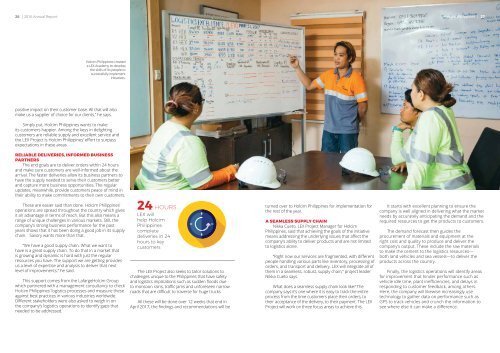HOLCIM AR 2016 FA_LR 5-26-17
You also want an ePaper? Increase the reach of your titles
YUMPU automatically turns print PDFs into web optimized ePapers that Google loves.
<strong>26</strong> | <strong>2016</strong> Annual Report<br />
Holcim Philippines | 27<br />
Holcim Philippines created<br />
a LEX Academy to develop<br />
the skills of its people to<br />
successfully implement<br />
initiatives.<br />
positive impact on their customer base. All that will also<br />
make us a supplier of choice for our clients,” he says.<br />
Simply put, Holcim Philippines wants to make<br />
its customers happier. Among the keys in delighting<br />
customers are reliable supply and excellent service and<br />
the LEX Project is Holcim Philippines’ effort to surpass<br />
expectations in these areas.<br />
RELIABLE DELIVERIES, INFORMED BUSINESS<br />
P<strong>AR</strong>TNERS<br />
The end goals are to deliver orders within 24 hours<br />
and make sure customers are well-informed about the<br />
arrival. The faster deliveries allow its business partners to<br />
have the supply needed to serve their customers better<br />
and capture more business opportunities. The regular<br />
updates, meanwhile, provide customers peace of mind in<br />
their ability to make commitments to their own customers.<br />
These are easier said than done. Holcim Philippines’<br />
operations are spread throughout the country which gives<br />
it an advantage in terms of reach. But this also means a<br />
range of unique challenges in various markets. Still, the<br />
company’s strong business performance for the past<br />
years shows that it has been doing a good job in its supply<br />
chain. Savory wants more than that.<br />
“We have a good supply chain. What we want to<br />
have is a great supply chain. To do that in a market that<br />
is growing and dynamic is hard with just the regular<br />
resources you have. The support we are getting provides<br />
us a level of expertise and analysis to deliver that next<br />
level of improvements,” he said.<br />
This support comes from the LafargeHolcim Group<br />
which partnered with a management consultancy to check<br />
Holcim Philippines’ logistics processes and measure these<br />
against best practices in various industries worldwide.<br />
Different stakeholders were also asked to weigh in on<br />
the company’s logistics operations to identify gaps that<br />
needed to be addressed.<br />
24 HOURS<br />
LEX will<br />
help Holcim<br />
Philippines<br />
complete<br />
deliveries in 24<br />
hours to key<br />
customers<br />
The LEX Project also seeks to tailor solutions to<br />
challenges unique to the Philippines that have safety<br />
and logistics implications such as sudden floods due<br />
to monsoon rains, traffic jams and unforeseen narrow<br />
roads that are difficult to traverse for huge trucks.<br />
All these will be done over 12 weeks that end in<br />
April 20<strong>17</strong>, the findings and recommendations will be<br />
turned over to Holcim Philippines for implementation for<br />
the rest of the year.<br />
A SEAMLESS SUPPLY CHAIN<br />
Nikka Cueto, LEX Project Manager for Holcim<br />
Philippines, said that achieving the goals of the initiative<br />
means addressing the underlying issues that affect the<br />
company’s ability to deliver products and are not limited<br />
to logistics alone.<br />
“Right now our services are fragmented, with different<br />
people handling various parts like inventory, processing of<br />
orders, and transport and delivery. LEX will integrate all of<br />
them in a seamless, robust, supply chain,” project leader<br />
Nikka Cueto says.<br />
What does a seamless supply chain look like? The<br />
company says it’s one where it is easy to track the entire<br />
process from the time customers place their orders, to<br />
their acceptance of the delivery, to their payment. The LEX<br />
Project will work on three focus areas to achieve this.<br />
It starts with excellent planning to ensure the<br />
company is well aligned in delivering what the market<br />
needs by accurately anticipating the demand and the<br />
required resources to get the products to customers.<br />
The demand forecast then guides the<br />
procurement of materials and equipment at the<br />
right cost and quality to produce and deliver the<br />
company’s output. These include the raw materials<br />
to make the cement to the logistics resources—<br />
both land vehicles and sea vessels—to deliver the<br />
products across the country.<br />
Finally, the logistics operations will identify areas<br />
for improvement that hinder performance such as<br />
vehicle idle time, plant inefficiencies, and delays in<br />
responding to customer feedback, among others.<br />
Here, the company will likewise increasingly use<br />
technology to gather data on performance such as<br />
GPS to track vehicles and crunch the information to<br />
see where else it can make a difference.


